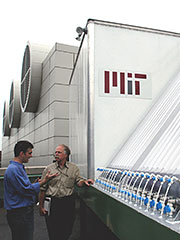Algae system transforms greenhouse emissions into green fuel
For the past year, exhaust from MIT’s main power plant has been bubbling up through tubes of algae soup. The result? A dramatic cut in carbon dioxide (CO2) emissions—and abundant algae that can be turned into biofuel for the power plant or a diesel vehicle. Utility companies have been watching field trials of the algae-soup system with keen interest, hoping to combine low-cost exhaust cleanup with renewable-fuel production.
This novel technology is the brainchild of Isaac Berzin, founder and chief technology officer of GreenFuel Technologies Corp., which markets the system. As an MIT postdoc in chemical engineering, Berzin became intrigued with using algae to clean up exhaust from power plants burning fossil fuels, especially coal. Coal is an abundant resource but an undesirable fuel because of its high CO2 emissions. “Other types of emissions can now be controlled,” said Berzin, “but controlling CO2 at low cost is still a challenge.”
One option is algae. These fast-growing, single-celled organisms gobble up CO2 during photosynthesis. Moreover, they split nitrogen oxides—a precursor to smog—into harmless nitrogen and oxygen. And they’re hardy creatures, thriving in conditions ranging from the Antarctic to the Yellowstone geysers to the Great Salt Lake.
The installation on MIT’s 20-megawatt cogeneration plant demonstrates their abilities. Atop the plant are thirty 3-meter-high triangles of clear pipe containing a mixture of algae and water. Bubbling the plant’s flue gases through the mixture has reduced CO2 emissions by 82 percent on sunny days and 50 percent on cloudy days (during daytime) and has cut nitrogen oxides by 85 percent (on a 24-hour basis).


